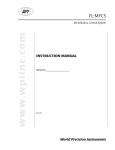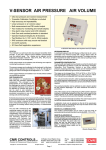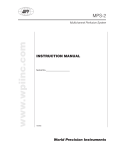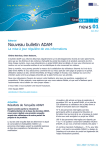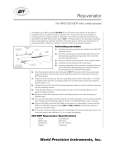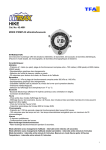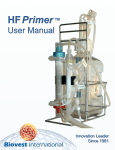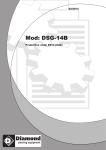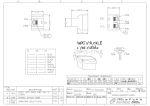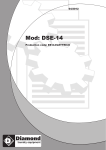Download ISO-HPO-100 Instruction Manual
Transcript
ISO-HPO-100 www.wpiinc.com Microsensor for H2O2 Measurement INSTRUCTION MANUAL Serial No._____________________ 121412 World Precision Instruments ISO-HPO-100 CONTENTS ABOUT THIS MANUAL ..................................................................................................................... 1 INTRODUCTION .................................................................................................................................. 2 Notes and Warnings .................................................................................................................... 2 INSTRUMENT DESCRIPTION .......................................................................................................... 3 Parts List ........................................................................................................................................... 3 Unpacking ....................................................................................................................................... 3 OPERATING INSTRUCTIONS........................................................................................................... 4 Attaching the Sensor to the Microsensor Handle.............................................................. 4 Polarizing the Sensor ................................................................................................................... 4 Calibrating the Sensor ................................................................................................................. 4 Standard Test ............................................................................................................................ 5 INSTRUMENT MAINTENANCE....................................................................................................... 7 Storing the Sensor......................................................................................................................... 7 Cleaning the Sensor ..................................................................................................................... 7 ACCESSORIES ....................................................................................................................................... 8 TROUBLESHOOTING ......................................................................................................................... 9 SPECIFICATIONS ................................................................................................................................10 WARRANTY ........................................................................................................................................11 Claims and Returns ....................................................................................................................11 Repairs ............................................................................................................................................11 Copyright © 2012 by World Precision Instruments, Inc. All rights reserved. No part of this publication may be reproduced or translated into any language, in any form, without prior written permission of World Precision Instruments, Inc. World Precision Instruments iii ISO-HPO-100 iv World Precision Instruments ISO-HPO-100 ABOUT THIS MANUAL The following symbols are used in this guide: This symbol indicates a CAUTION. Cautions warn against actions that can cause damage to equipment. Please read these carefully. This symbol indicates a WARNING. Warnings alert you to actions that can cause personal injury or pose a physical threat. Please read these carefully. NOTES and TIPS contain helpful information. Ins ert Mi cro Mi se sen so ns or rc Ca ble (91 58 cro sen so on ne cto r in to 0) mi cro sen so rC ab le (91 58 0) co nn rc ab le ect or Fig. 1–ISO-HPO-100 microsensor with cable World Precision Instruments 1 ISO-HPO-100 INTRODUCTION The ISO-HPO-100 is a 100μm tip diameter hydrogen peroxide micro sensor designed for use in tissues, vessels and similar applications. The sensor design is based on a flexible, sensing electrode coated with a unique membrane that enhances hydrogen peroxide selectivity. The ISO-HPO-100 incorporates WPI’s proprietary combination electrode technology whereby the hydrogen peroxide sensing element and separate reference electrode are encased within a single sensor design. The ISO-HPO-100 is also available with a hypodermic sheath (#ISO-HPO-100H) or as an L-shape for use with a tissue bath or in monolayer-style cell culture studies (#ISO-HPO-100L). Notes and Warnings Exercise caution when handling the H2O2 sensor to avoid actions that could damage the sensor tip. The sensor membrane and membrane coatings are extremely delicate and improper handling will lead to damage. See ”Unpacking” on page 3. CAUTION: DO NOT EXPOSE SENSOR TO ORGANIC SOLVENTS. CAUTION: DO NOT POLARIZE IN DISTILLED WATER. CAUTION: Carefully read the “Probe Unpacking” instructions (found in the sealed sensor case) before handling the sensor. 2 World Precision Instruments ISO-HPO-100 INSTRUMENT DESCRIPTION Parts List After unpacking, verify that there is no visible damage to the sensor. Verify that all items are included: (3) ISO-HPO-100 microsensor (3) Sensor Performance Evaluation (1) Instruction Manual Unpacking Upon receipt of these sensors, make a thorough inspection of the contents and check for possible damage. Missing cartons or obvious damage to cartons should be noted on the delivery receipt before signing. Concealed damage should be reported at once to the carrier and an inspection requested. Please read the section entitled “Claims and Returns” on page 11of this manual. Please contact WPI Customer Service if any parts are missing at 941.371.1003 or [email protected]. The ISO-HPO-100 microsensor is shipped in a sealed, rigid plastic, hinged box with foam padding to protect it from damage during shipment. To open the package, carefully cut the seals on either side of the sensor box. Due to the microsensor’s extremely small size and intricate construction, great caution should be used when handling it. Avoid bringing the sensor tip into contact with solid surfaces, since this may bend or break it. The sensors are packaged in foam holders so that their tips are physically isolated from contact with the container. To remove a microsensor from the package, use the thumb and index finger of one hand to separate the slit in the foam which contains the sensor and use the thumb and index finger of the other hand to grasp the sensor at its midsection and gently remove it from the container. KEEP THE SENSOR STORAGE BOX and all the documentation in a safe place. The test date and serial number of each sensor is printed on the bottom of its box. Use of the sensor should begin within 30 days of receipt. Returns: Do not return any goods to WPI without obtaining prior approval (RMA # required) and instructions from WPI’s Returns Department. Goods returned (unauthorized) by collect freight may be refused. If a return shipment is necessary, use the original container, if possible. If the original container is not available, use a suitable substitute that is rigid and of adequate size. For further details, please read the section entitled “Claims and Returns” on page 11 of this manual. World Precision Instruments 3 ISO-HPO-100 OPERATING INSTRUCTIONS Attaching the Sensor to the Microsensor Handle Once removed from the package, plug the microsensor into a microsensor cable (WPI #91580) connected to the free radical analyzer, again being very careful that the sensor tip does not come into contact with anything which could damage it. See page 1. The sensor should plug in easily. If you encounter resistance, it is probably due to misalignment of the sensor plug with the socket connector inside the microsensor cable. Simply realign the sensor by gently rotating it until it snaps into place. Current WPI free radical analyzers include the TBR4100, TBR1025 and Apollo1000. Apollo4000 is an older WPI free radical analyzer. Polarizing the Sensor When a non-polarized microsensor is initially connected to a monitoring instrument, it may display a high (sometimes off-scale) background current. The polarization voltage applied by the instrument will cause a reduction of the background current to a stabilized baseline value over time. Set the poise voltage to 400mV. (For the TBR4100/1025, set the Probe Select dial to HPO. ) The amount of time required to reach a stable baseline current varies for each sensor. New sensors typically take longer, on the order of several hours. The Performance Evaluation included with your sensor shows the baseline current when the sensor was quality tested at WPI. The baseline value attainable in your lab may be slightly higher or lower, depending on the temperature* and composition of the test media. For initial performance verification of an ISO-HPO-100 in your lab, WPI recommends using the Standard Test described on page 5. Once a stable baseline current is achieved (usually between 10-2000pA), the microsensor is ready for use. *NOTE: The background current of the sensor will usually increase with increasing temperature of the experiment. Although, the sensitivity of the sensor does not change significantly within the range 20-37°C, it is recommended that any calibration should be performed at the same temperature as the experiment. Calibrating the Sensor NOTE: For detailed sensor calibration procedures and calibration theory, refer to the free radical analyzer manual. Most WPI manuals can be downloaded directly from www.wpiinc.com. This information can also be e-mailed when you contact the WPI Technical Support team at 941.371.1003 or [email protected]. Before attempting to use the ISO-HPO-100 sensor in an experimental solution, calibrate it under standard conditions to verify proper operation and performance. If you have purchased several WPI sensors, all sensors should be calibrated upon receipt at your facility. Although WPI takes great care in packaging the sensors to avoid the possibility of damage, the sensors are delicate. Testing the sensors soon 4 World Precision Instruments ISO-HPO-100 after arrival at your facility ensures that the sensors arrived intact. The standard test is performed at room temperature, or approximately 25°C. H2O2 sensors are sensitive to changes in temperature, ion concentration and pH. Therefore, WPI recommends calibrating sensors under the experimental conditions. It is especially important to use the same temperature during calibration that is used during experimentation. Standard Test If you experience problems in using the ISO-HPO-100 in your experiment, it is a good idea to run the standard test to verify that the sensor operates properly under controlled conditions. To test the ISO-HPO-100, gather the following supplies: • Solution #1: 200mL of 0.1M PBS buffer–Use (1) Sigma tablet (Sigma-Aldrich #P4417-100TAB) dissolved into 200mL distilled water (dH2O) • Solution #2: 20mL of 1mM H2O2–Weigh 67.5mg Acetanilide (Sigma-Aldrich 397237) and dissolve it into 250mL of dH2O in a volumetric flask. Remove 1mL of this solution and put it in a clean container. Add 231L of 3% H2O2 (SigmaAldrich #323381). Then, add dH2O to make a total volume of 250mL. Store this stock solution in an amber bottle, if available. Alternatively, wrap aluminum foil around the bottle to limit light intrusion. Keep refrigerated. • 20mL vial • Magnetic stirring plate with a stirring bar small enough to fit in the 20mL vial • Electrode holder for suspending the electrode within the test vial (hands free) • Pipetters to dispense L aliquots from the 1mM H2O2 test solution • (2) 250mL volumetric flasks or other containers suitable for mixing solutions • 250mL amber bottle for storing 1mM H2O2 solution To test the sensor: 1. Measure 20mL of PBS (Solution #1) and put it into a vial that will hold it. 2. Drop a small stirring bar into the solution and place the vial on top of a magnetic stirring plate. The RPM on the stirring plate should be set high enough to rapidly disperse aliquots of Solution #2 throughout the buffer. 3. When no sensor is connected, there is no sensor redox current. With the sensor disconnected from the free radical analyzer, verify that the output reading is very close to zero. If the output is not close to zero, then adjust the output to zero according to the directions in the user’s manual of the free radical analyzer. NOTE: The Apollo1000 is the only WPI analyzer with a zero output level adjustment. For other WPI analyzers, there is no zero current adjustment. If the analyzer does not output zero volts with no sensor connected, then contact the WPI technical support team at 941.371.1003 or [email protected] for possible return for adjustment or repair. World Precision Instruments 5 ISO-HPO-100 4. Adjust the settings of the free radical analyzer for H2O2. Poise voltage should be set at 400mV. 5. Connect the sensor to the free radical analyzer using the microsensor cable (WPI #91580). 6. Using a suitable electrode holder like the ProGuide (WPI #47520) or ProGuide Plus (WPI #47530), suspend the tip of the microsensor in the 0.1M PBS solution. Submerge the tip so that the liquid completely covers the sensor active area. Typically, 1cm or more below the surface is adequate. 7. Allow time for the background current to drop to a stable baseline value (1000pA or less) with the free radical analyzer set in the 10nA range. This may take 2-4 hours. See “Polarizing the Sensor” on page 4. NOTE: The sensor may be left in the PBS buffer solution overnight to polarize. 8. After the sensor has stabilized to an acceptable baseline current (typically between 150-1000pA), record the baseline value. This information is useful as an indicator of the general condition of the electrode as it ages. 9. If desired, establish a zero reference line on the recording software or chart recorder. Alternatively, record the raw voltage from the sensor and subtract the baseline current from the measured test values. 10. In sequence, pipette three aliquots (2μL, 4μL and 8μL) of Solution #2 (1mM H2O2) into the 20mL vial containing the 20mL of 0.1M PBS buffer (Solution #1), and observe the output after each addition. • These aliquots correspond to calculated concentrations of 100nM, 200nM and 400nM, respectively. • The aliquots should be added about 30-45 seconds apart. • Each successive aliquot doubles the concentration of H2O2, and a corresponding output that is linearly proportional to the concentration should be observed. • The nominal sensitivity of a fresh ISO-HPO-100 sensor is 1pA/nM, or better. As the electrode ages, its sensitivity decreases. So, test the sensor before each experiment to validate its sensitivity. 11. Create a calibration curve using the observed data. Plot the changes in current (pA) against the changes in concentration (mM) that are calculated. The slope of the curve indicates the sensitivity of the sensor. The sensor is usable as long as the baseline current is within an acceptable range (1000pA or less when the free radical analyzer is set in the 10nA range), the response is linear for the intended measurement range, and there is adequate resolution for the purpose of the application. 6 World Precision Instruments ISO-HPO-100 INSTRUMENT MAINTENANCE Storing the Sensor STANDBY: When not being used for a short period of time (such as overnight), the microsensor should remain attached to the microsensor cable and immersed into buffer solution, such as PBS. Before the next experiment, the sensor can be transferred from the buffer solution to the experimental solution. LONG-TERM: If the microsensor is to be stored for a long period of time, then it may be stored dry by removing it from the microsensor cable and returning it to the case in which it was shipped, being very careful to avoid making contact with the sensor tip. The H2O2 microsensor is a maintenance free consumable sensor. When it no longer functions, remove it from the microsensor cable and dispose of it, replacing it with a new one. Cleaning the Sensor The sensor should be cleaned after each use. If the sensor was used in a protein-rich solution, the tip should first be soaked in a protease solution for several minutes to remove protein build-up and then rinsed with distilled water. Enzymatic detergent (Enzol, WPI #7363-4) can also be used. The sensor can be sterilized chemically using an appropriate disinfectant (Cidex, WPI #7364). If necessary, gently dab the sensor with a Kimwipes® to remove residue. NOTE: ALWAYS rinse with distilled water before storing the sensor dry. World Precision Instruments 7 ISO-HPO-100 ACCESSORIES Table 1: Accessories Part Number 7363-4 7364 91580 47510 47520 47530 47540 NOCHM-4 8 Description Enzol Enzymatic Detergent, 1 gallon Cidex Disinfecting Solution Microsensor Cable ProGuide Postion/Holder with Base ProGuide Position/Holder ProGuide Plus Position/Holder with fine adjustment ProGuide Plus with Base Four-port Closed Chamber World Precision Instruments ISO-HPO-100 Possible Cause Solution The poise voltage (sensor setting) may be incorrectly set or sensor has drift Set the poise voltage to 400mV. (For the TBR, choosing the HPO sensor setting selects 400mV automatically.) Set the range at 10nA. The sensor may be nearing the end of its usable life. Perform a 3-point calibration set using the standard. If successful, the sensor is functioning properly. See “Calibrating the Sensor” on page 4. If the baseline hasn’t stabilized after 1 hour , the polarizing solution may be contaminated. Prepare fresh polarizing solution. Use 0.1M PBS only. External electrical interferences may be the problem. Identify and isolate electrical interferences. The dilution factors may be incorrect. See “Calibrating the Sensor” on page 4. Verify the procedure used. Sensitivity Calibration dataset is not linear. below range specified Unstable baseline Issue Baseline current is below specified range. TROUBLESHOOTING Uneven aliquots may have been Check the pipetter calibration and used. aliquot placement (injection spike). The standard solutions may be unstable. Verify that there is stabilizer in H2O2 standard. See “Calibrating the Sensor” on page 4. The standard solution has expired. Prepare fresh H2O2 standard solution. See “Calibrating the Sensor” on page 4. The sensor has reached end of its usable life. Replace the sensor. NOTE: If you have a problem/issue with your ISO-HPO-100 type sensor that falls outside the definitions of this troubleshooting section, first perform the Standard Test exactly as describe on page 5 of this manual and contact the WPI Technical Support team at 941.371.1003 or [email protected]. World Precision Instruments 9 ISO-HPO-100 SPECIFICATIONS The ISO-HPO-100 type sensors conform to the following specifications: Outside Diameter 100μm Available Length 4mm Response Time < 5 sec Lowest Detection Limit/Range 1nM Upper Detection LImit/Range 1mM Sensitivity (New Sensor) Interferent (Selectivity Coefficient) Baseline Drift Poise Voltage Typical Quiescent Baseline Current, 25ºC Acceptable Baseline Range Polarization Time Recommended Polarization Solution Temperature Dependent Physiological Interference Recommended pH Range 10 ≥1pA/nM Ascorbate (1/10 -1/50) <2.0pA/min 400mV <1000pA 150-1200pA 1+ hours 95% 0.1M PBS Slight Yes 6-8 World Precision Instruments ISO-HPO-100 WARRANTY WPI (World Precision Instruments, Inc.) warrants to the original purchaser that this equipment, including its components and parts, shall be free from defects in material and workmanship for a period of 30 days* from the date of receipt. WPI’s obligation under this warranty shall be limited to repair or replacement, at WPI’s option, of the equipment or defective components or parts upon receipt thereof f.o.b. WPI, Sarasota, Florida U.S.A. Return of a repaired instrument shall be f.o.b. Sarasota. The above warranty is contingent upon normal usage and does not cover products which have been modified without WPI’s approval or which have been subjected to unusual physical or electrical stress or on which the original identification marks have been removed or altered. The above warranty will not apply if adjustment, repair or parts replacement is required because of accident, neglect, misuse, failure of electric power, air conditioning, humidity control, or causes other than normal and ordinary usage. To the extent that any of its equipment is furnished by a manufacturer other than WPI, the foregoing warranty shall be applicable only to the extent of the warranty furnished by such other manufacturer. This warranty will not apply to appearance terms, such as knobs, handles, dials or the like. WPI makes no warranty of any kind, express or implied or statutory, including without limitation any warranties of merchantability and/or fitness for a particular purpose. WPI shall not be liable for any damages, whether direct, indirect, special or consequential arising from a failure of this product to operate in the manner desired by the user. WPI shall not be liable for any damage to data or property that may be caused directly or indirectly by use of this product. Claims and Returns Inspect all shipments upon receipt. Missing cartons or obvious damage to cartons should be noted on the delivery receipt before signing. Concealed loss or damage should be reported at once to the carrier and an inspection requested. All claims for shortage or damage must be made within ten (10) days after receipt of shipment. Claims for lost shipments must be made within thirty (30) days of receipt of invoice or other notification of shipment. Please save damaged or pilfered cartons until claim is settled. In some instances, photographic documentation may be required. Some items are time-sensitive; WPI assumes no extended warranty or any liability for use beyond the date specified on the container Do not return any goods to us without obtaining prior approval and instructions from our Returns Department. Goods returned (unauthorized) by collect freight may be refused. Goods accepted for restocking will be exchanged or credited to your WPI account. Goods returned which were ordered by customers in error are subject to a 25% restocking charge. Equipment which was built as a special order cannot be returned. Repairs Contact our Customer Service Department for assistance in the repair of apparatus. Do not return goods until instructions have been received. Returned items must be securely packed to prevent further damage in transit. The Customer is responsible for paying shipping expenses, including adequate insurance on all items returned for repairs. Identification of the item(s) by model number, name, as well as complete description of the difficulties experienced should be written on the repair purchase order and on a tag attached to the item. * Electrodes, batteries and other consumable parts are warranted for 30 days only from the date on which the customer receives these items. World Precision Instruments 11 World Precision Instruments, Inc. USA International Trade Center, 175 Sarasota Center Blvd., Sarasota FL 34240-9258 Tel: 941-371-1003 • Fax: 941-377-5428 • E-mail: [email protected] UK 1 Hunting Gate, Hitchin, Hertfordshire SG4 0TJ Tel: 44 (0)1462 424700 • Fax: 44 (0)1462 424701 • E-mail: [email protected] Germany Zossener Str. 55, 10961 Berlin Tel: 030-6188845 • Fax: 030-6188670 • E-mail: [email protected] China & Hong Kong WPI Shanghai Trading Co., Ltd. Rm 20a, No8 Dong Fang Rd., Lu Jia Zui Financial District, Shanghai PRC Tel: +86 688 85517 • E-mail:[email protected] Internet www.wpiinc.com • store.wpiinc.com www.wpi-europe.com • www.wpiinc.cn



















